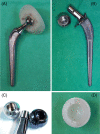Similarly low blood metal ion levels at 10-years follow-up of total hip arthroplasties with Oxinium, CoCrMo, and stainless steel femoral heads. Data from a randomized clinical trial
- PMID: 36356214
- PMCID: PMC10099800
- DOI: 10.1002/jbm.b.35193
Similarly low blood metal ion levels at 10-years follow-up of total hip arthroplasties with Oxinium, CoCrMo, and stainless steel femoral heads. Data from a randomized clinical trial
Abstract
The use of inert head materials such as ceramic heads has been proposed as a method of reducing wear and corrosion products from the articulating surfaces in total hip arthroplasty, as well as from the stem-head taper connection. The aim of the present study was to compare the blood metal ion levels in patients with Oxinium and CoCrMo modular femoral heads, as well as monoblock stainless steel Charnley prostheses at 10 years postoperatively. The 150 patients with osteoarthritis of the hip joint included in a randomized clinical trial were grouped according to femoral head material. One group (n = 30) had received the Charnley monoblock stainless steel stem (DePuy, UK). The other patients (n = 120) received a Spectron EF CoCrMo stem with either a 28 mm CoCrMo or Oxinium modular head (Smith & Nephew, USA). After 10 years, 38 patients had withdrawn, 19 deceased, 7 revised due to aseptic loosening and 5 revised due to infection. The 81 patients with median age of 79 years (70-91) were available for whole blood metal ion analysis. The levels of Co, Cr, Ni and Zr in the blood were generally low with all the head materials (medians <0.3 micrograms/L) and no statistical difference between the groups were found (p = .2-.8). Based on the low blood metal ion values in our study groups, no indication of severe trunnion corrosion in patients with CoCrMo heads was observed, neither was there any beneficial reduction in metal ion exposure with the Oxinium femoral heads.
Keywords: RCT; arthroplasty; blood metal ion; chromium; cobalt; modular stem; oxidized zirconium; oxinium; trunnionosis.
© 2022 The Authors. Journal of Biomedical Materials Research Part B: Applied Biomaterials published by Wiley Periodicals LLC.
Conflict of interest statement
The authors declare that they have no competing interests.
Figures



References
-
- Dahlstrand H, Stark A, Wick MC, Anissian L, Hailer NP, Weiss RJ. Comparison of metal ion concentrations and implant survival after total hip arthroplasty with metal‐on‐metal versus metal‐on‐polyethylene articulations. Acta Orthop. 2017;88(5):490‐495. doi:10.1080/17453674.2017.1350370 - DOI - PMC - PubMed
Publication types
MeSH terms
Substances
Grants and funding
LinkOut - more resources
Full Text Sources
Medical

